Before we dive deeper into comparing Klaviyo vs Mailchimp, we’d like to mention that both ESPs are powerful tools that will help you reach your target audience with relevant, personalized messages.
And even though these two ESPs have a lot of the same/similar features, they are most definitely not identical. What are the differences, which platform do we recommend, and what would be the perfect fit for your business? These are some of the questions that we’ll try to answer in this article.
Difference Between Mailchimp and Klaviyo
Firstly, Klaviyo is an email marketing platform built for eCommerce, while Mailchimp is an email marketing platform made for any kind of business.
With years of experience in the email marketing industry, and over 100+ satisfied clients we have had since starting our company, we strongly recommend Klaviyo when it comes to email marketing software. As an ESP specifically designed for online stores, Klaviyo offers robust features to help you sell, not just send emails.
In case you’re also looking to connect with your customers through SMS, Klaviyo provides an SMS platform that works in sync with your emails, for even better results.
Migrate from Mailchimp to Klaviyo today
Klaviyo vs Mailchimp for eCommerce: 12 Points of Comparison
If we compare Klaviyo and Mailchimp for non-eCommerce businesses (businesses that don’t sell physical products online), Mailchimp wins, no questions asked.
However, when we compare Klaviyo and Mailchimp for eCommerce businesses, it takes a closer look to define the winner. And it would be up to you to make the decision based on your business needs, budget, etc.
Spoiler alert: We love Klaviyo. (We’re proud to be Klaviyo Elite Master Partners)
But we’ll do our best to be as objective as possible.
Comparison structure:
- Part 1: Dashboard
- Part 2: Campaigns
- Part 3: Integrations
- Part 4: Analytics vs. Reports
- Part 5: Flows vs. Automation
- Part 6: Segments
- Part 7: Subscribers Profile
- Part 8: Opt-In Forms
- Part 9: Support
- Part 10: Other Features
- Part 11: User Interface
- Part 12: Pricing
1. Dashboard
The Klaviyo and Mailchimp dashboards are similar and you can easily see your profits from your email marketing efforts on both platforms.
The main difference –– which might seem small, but for us personally is impactful, is the percentage.
Klaviyo shows how much percentage of your total revenue you make from email, automated email, and campaigns.
Wondering why is this so helpful for our team? Well, it’s mostly because when we talk with a potential client and they tell us that their revenue from email marketing is less than 30% of their total revenue – you see, that’s when we know for sure that our team of email marketing experts can help them.
Here’s a Mailchimp dashboard snapshot:
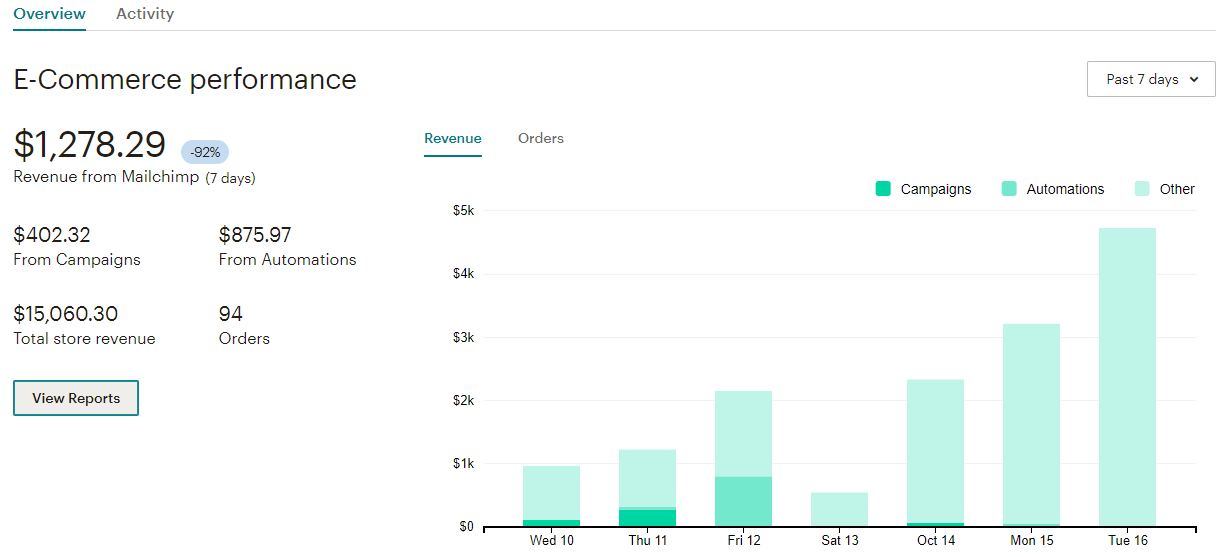
Here is a Klaviyo dashboard snapshot:
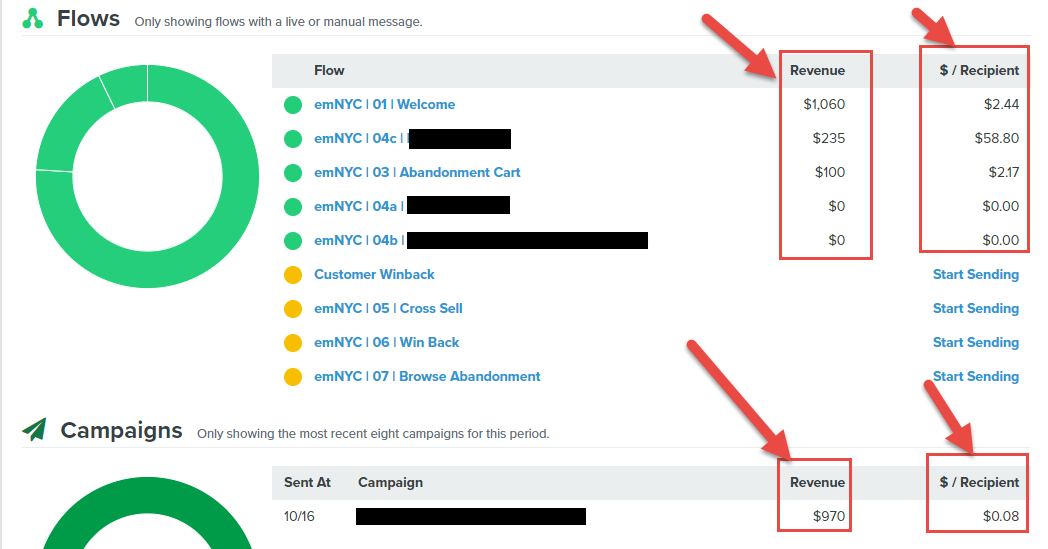
Another cool feature of Klaviyo’s dashboard which is not available in Mailchimp is the breakdown of revenue by automated emails (flows) and campaigns.
2. Klaviyo vs Mailchimp Campaigns
Klaviyo and Mailchimp campaign builders are very similar and have a lot of the same features. Both campaign builders are visual.
The campaign builder consists of blocks that you can drag and drop.
A unique feature of both platforms is the product block. However, the way product block works differ between the platforms.
On the Klaviyo platform, you can either use the product feed or pick a product from your store.
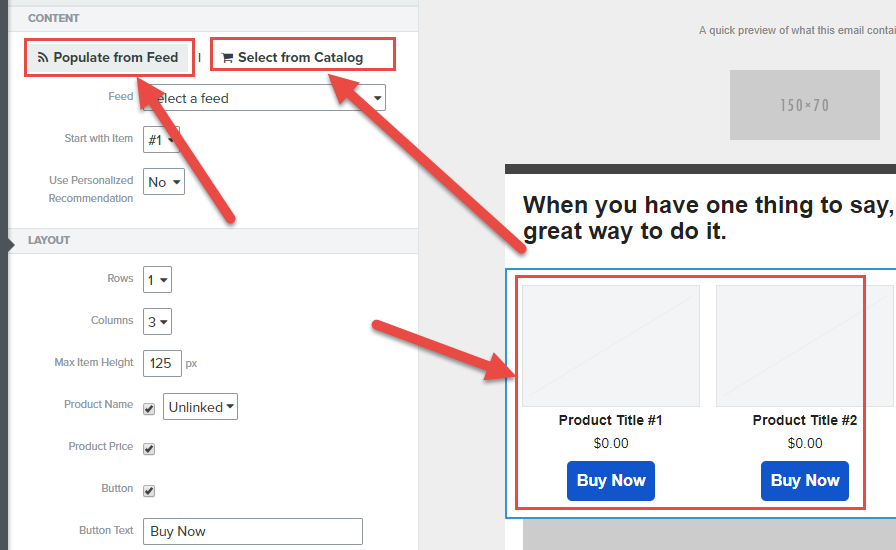
The “select from a catalog” is the same option as in Mailchimp. However, the ability to populate from your feed is different and more robust.
You basically create a product feed from your store where you specify which product category or collection to show and then it dynamically populates that block within the email.
But in Mailchimp, this option is limited – which means you can only show popular products and not specific categories, collections, and/or tags.
How can it impact your business? Well, let’s say you have man and woman’s products for e.g. It does not make sense to show men’s products to women, and vice versa. But in Klaviyo, you can create woman’s product blocks and man’s product blocks and display them to the right segment. This is what helps make your email much more personalized and it will also have a huge impact on your CTRs and eventually the most important thing – REVENUE.
3. Integrations
Both Klaviyo and Mailchimp have access to two types of integrations:
- Their own direct or native integrations
- Third-party tool integrations, such as Zapier’s library.
| Third-party tool integration | Direct (native) integration |
| Both Klaviyo and Mailchimp are part of Zapier’s integration tools.
That means you can connect Klaviyo and ActiveCampaign to hundreds of other software available in Zapier’s library. |
|
4. Analytics vs. Reports
Generally, both platforms have user-friendly reports. However, you need to upgrade to a PRO Mailchimp account to see an in-depth comparison report between automated emails and campaigns.
For Klaviyo, it is a standard feature that doesn’t require additional payment.
In addition, in Klaviyo you can customize your report views and save as many views as you want. Each view consists of cards. Each card can be customized to show the information you want.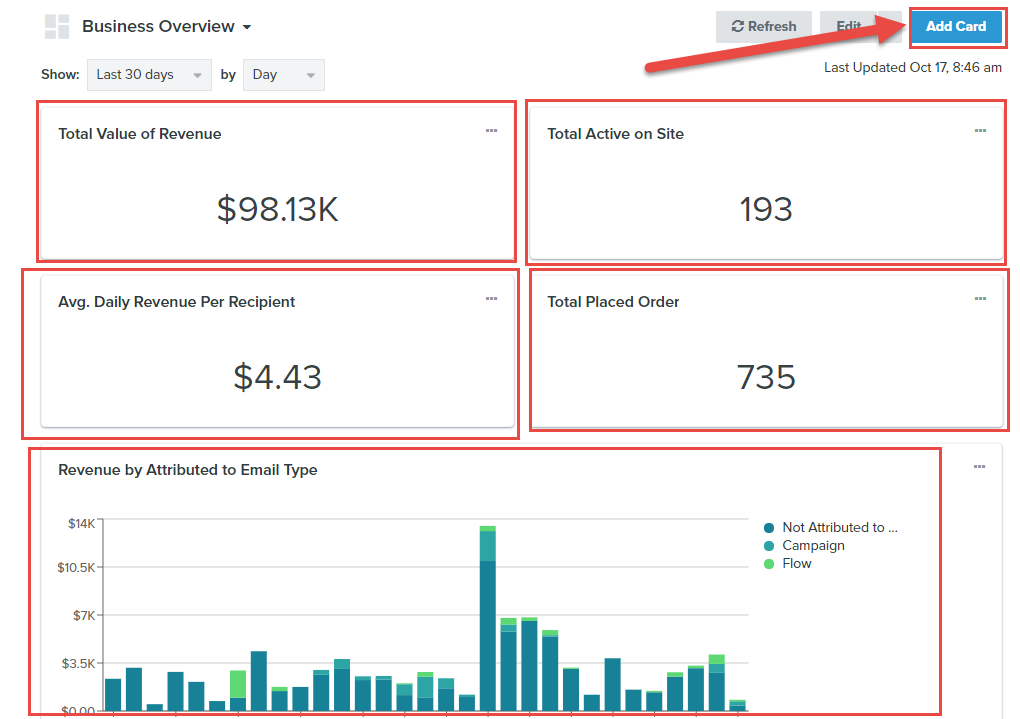
5. Flows vs. Automation
Klaviyo has a simple and powerful flow (automation) builder. You drag and drop actions and filters into the flow builder and it’s visually clear how the automation will work.
You have triggers that define how this automation should start. Then you have time delays (if any) and email at the end. Also, Klaviyo is constantly adding new updates, which helps improve the workflow build-out even more.
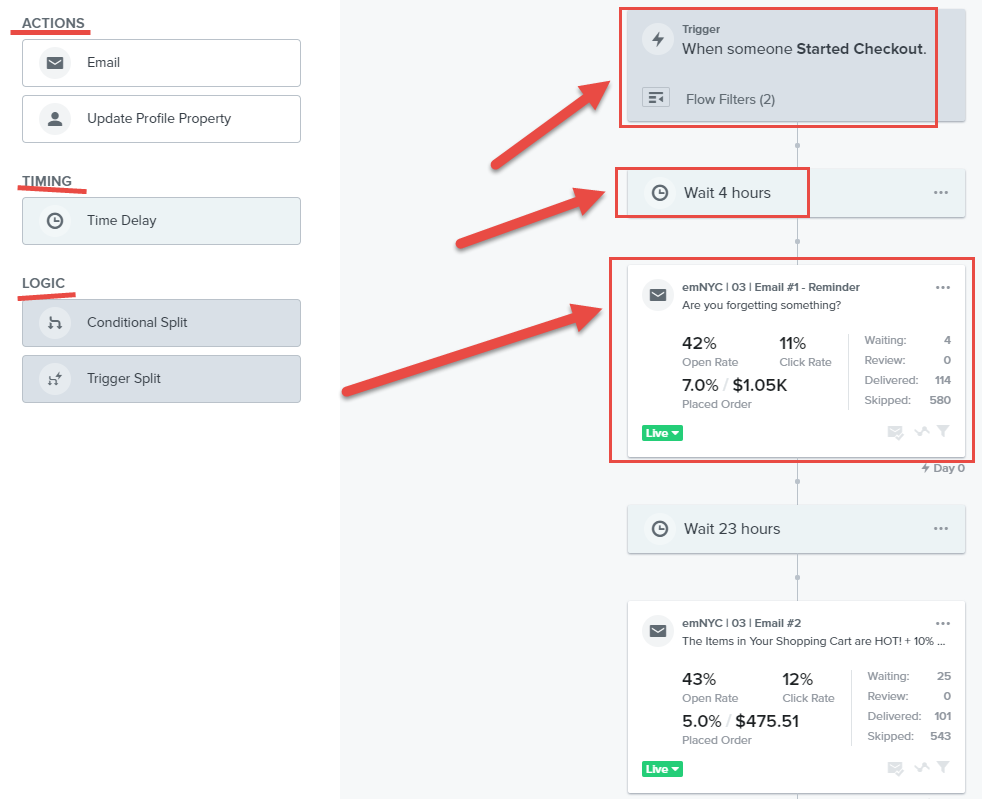
On Mailchimp, you do not have a visual builder, but instead a more logic-based automation builder. You add emails.
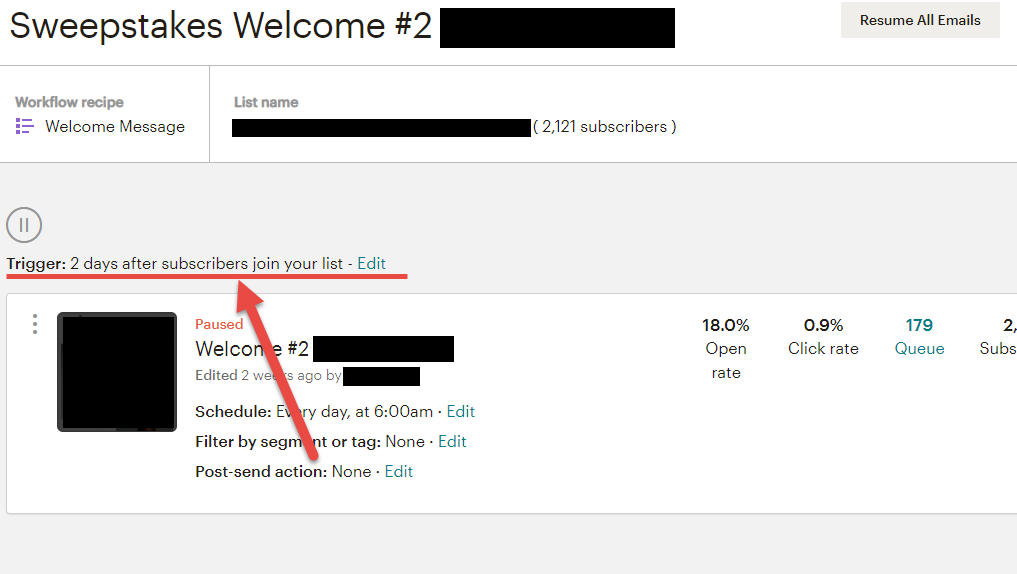
You might think they are interchangeable, but there’s probably a higher chance of making a mistake without the visuals.
Also, it is easier to create a visual diagram when you need to split your flow. See below:
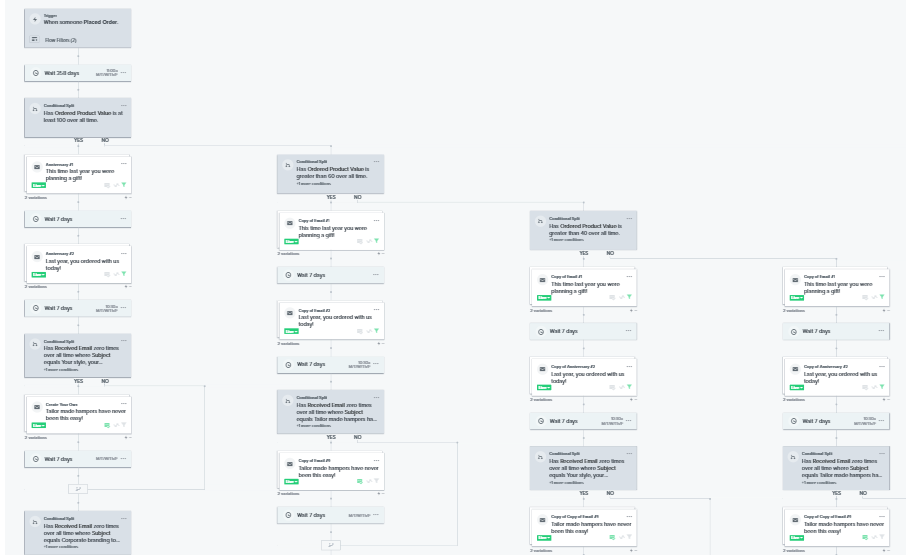
Klaviyo also has a “Browse Abandonment” trigger which is not available in Mailchimp. It is an email for those who viewed the product but did not buy it or add it to their cart.
After this trigger, the email goes to the subscriber and shows them which product they did not buy.

In other words, Klaviyo does not have automation limitations, you can create any kind of automation you want based on the data you have in Klaviyo.
6. Segments
Mailchimp segmentation is per list. In other words, if you want to create a segment where you say everybody who purchased X product, it will show you only people who were put on the list when you created the segment.
On the other hand, if you do the same in Klaviyo, it pulls from everybody in your account and it does not care what list that person is on.
Mailchimp segmentation is list-based. Klaviyo segmentation is global per account. Which is one of the most powerful features it offers.
Klaviyo has more robust segmentation and your imagination is the only limit for creating the segment since you can create any kind of segment you want based on the information you have in Klaviyo.
7. Subscribers Profile
For this section, we will show you two snapshots to compare and provide the overview below:
Mailchimp Subscriber Profile

Klaviyo Subscriber Profile

Those two snapshots are for the same subscriber. Since we recently moved this account to Klaviyo from Mailchimp, you still can see some emails which were sent using Mailchimp.
- Both software has similar analytics.
- However, you can customize the views in Klaviyo based on your preferences.
- In addition, you have predictive analytics which is very powerful for projections.
In general, we would say we have a tie here.
8. Opt-In Forms
Mailchimp opt-in forms are based on the lists. So, if you want to create a new form, you need to create a new list.
On the other hand, Klaviyo opt-in forms are based on your desire. With that in mind, you can create as many forms as you want and point all to one list or one form per list or however, you want/need.
Both software has drag-and-drop form builders. But in this case, we’d give the advantage to Klaviyo for sure, as you can accomplish much more with the forms without having to think about third-party apps, which is not the case with Mailchimp.
9. Support
In the past, it would take us a good 10-15 minutes to find Mailchimp support contact information. The support was helpful, but it was hard to find and required a Google search. They hide it, likely to reduce the number of requests.
Klaviyo support chat is:
- Available from 9 am to 5 pm (EST). They are a Boston-based company
- Very easy to find. It is in the top right corner under your account name
- Quick and extremely helpful.
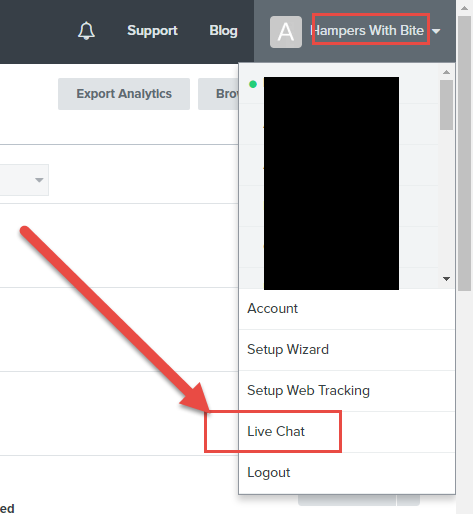
In addition, Mailchimp has three tiers of support based on the subscription plan you have. Klaviyo has one for all, even if you have a free Klaviyo account.
10. Other Features
Even though it’s obvious that we’re Klaviyo fans over here, it’s also important to mention that Mailchimp has some features which do not exist in Klaviyo.
Those features are:
- Landing pages
- Postcards.
For the landing page, you will need to pay extra if you plan to use a custom domain.
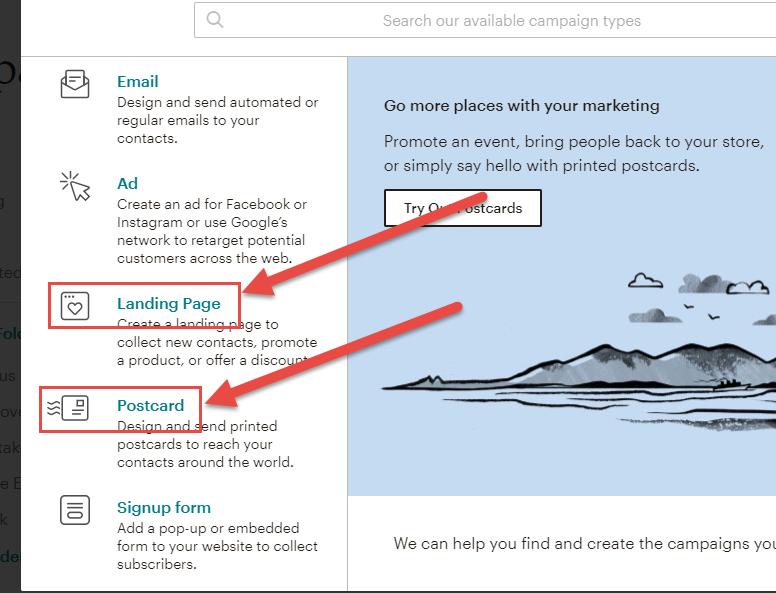
11. User Interface
So, Klaviyo vs Mailchimp User Interface… We’re sorry Mailchimp…but the Klaviyo team has a better understanding of user-friendliness.
For some projects in the past, you would need to be very creative to accomplish what you wanted in Mailchimp.
At first glance, you might think you had an easy project, but then with Mailchimp’s limitations, you would have to create many extra steps to accomplish the goal.
12. Klaviyo vs Mailchimp Pricing
Before we show you the price per subscriber comparison, we want to clarify how Klaviyo vs Mailchimp charges per subscriber.
| Klaviyo | Mailchimp |
| Subscriber-based | List-based |
| Two plans for everybody, pricing depends on the number of active subscribers | Three different plans with different features |
| Costs more |
Cheaper |
Klaviyo is subscriber-based. It means you pay only for active subscribers. We’ve created an article that explains Klaviyo pricing a bit more in-depth, so if you decide to give Klaviyo a chance, make sure you check out this blog post for all the information you need to choose the best plan for your business.
Mailchimp is list-based. For example, if you have five different lists in Mailchimp, and one contact (let’s say firstname@xyz.com) is on five different lists, you will pay five times for the same subscriber.
In Klaviyo, that same person (firstname@xyz.com) can be on five different lists, but you pay only once for this subscriber. Keep that in mind when you compare the pricing.
In addition, Klaviyo bases its pricing only on the number of subscribers and provides everybody with the same set of features. While on the other hand, Mailchimp has three different plans and some features are not available to other tiers.
Klaviyo costs more, there is no argument, but in our opinion, every penny is worth it.
If you just need a platform to send emails, Mailchimp is the right software for you. But, if you plan to make money and see how each email performs, plus take your email marketing to completely another level, you should definitely go with the Klaviyo.
Okay, so how much does Mailchimp cost compared to Klaviyo?
→ If you want to see our full pricing articles for both Mailchimp and Klaviyo, you can check them out here: Mailchimp Pricing vs. Klaviyo Pricing.
Klaviyo VS Mailchimp Pricing
| # of Subscribers | Klaviyo | Mailchimp |
|---|---|---|
| 0-500 | $25 | $0 |
| 501-2,500 | $50-$125 | $30.00 |
| 2,501-5,000 | $125-$200 | $50.00 |
| 5,000-10,000 | $200-$325 | $75.00 |
| 10,001-25,000 | $325-$450 | $150.00 |
Klaviyo vs Mailchimp: Final Thoughts
As mentioned before, since we’re Master Elite Klaviyo Partners, we really love Klaviyo and we intentionally stopped doing projects on Mailchimp’s platform a couple of years ago.
Why? Because we were not able to provide the same kind of results for our clients by using Mailchimp vs Klaviyo.
If you have an eCommerce business or are starting one, we highly recommend investing in the best software even if your budget is tight at the moment.
Even though Mailchimp offers free services for up to 2000 subscribers, sooner or later you will switch to Klaviyo and the migration will cost you more than you’ve saved.
We love this quote by Klaviyo:

→ If you want to try a Klaviyo account for free, click here to create a free account.
***Some links in this article are affiliated.
Migrate from Mailchimp to Klaviyo today
Frequently Asked Questions
Mailchimp is a great tool to send email campaigns. However, Klaviyo is conceived to help your eCommerce make money. The use of relevant data is at the core of the software, which helps you build highly personalized and targeted email campaigns.
Mailchimp functions with three pricing plans, and it’s overall more affordable than Klaviyo’s subscriber’ based pricing. However, experts’ opinion is that every penny is worth the investment in Klaviyo.
Landing pages and postcards are two features that Klaviyo doesn’t have. However, it is important to know that the landing pages feature is a paid one in Mailchimp.






